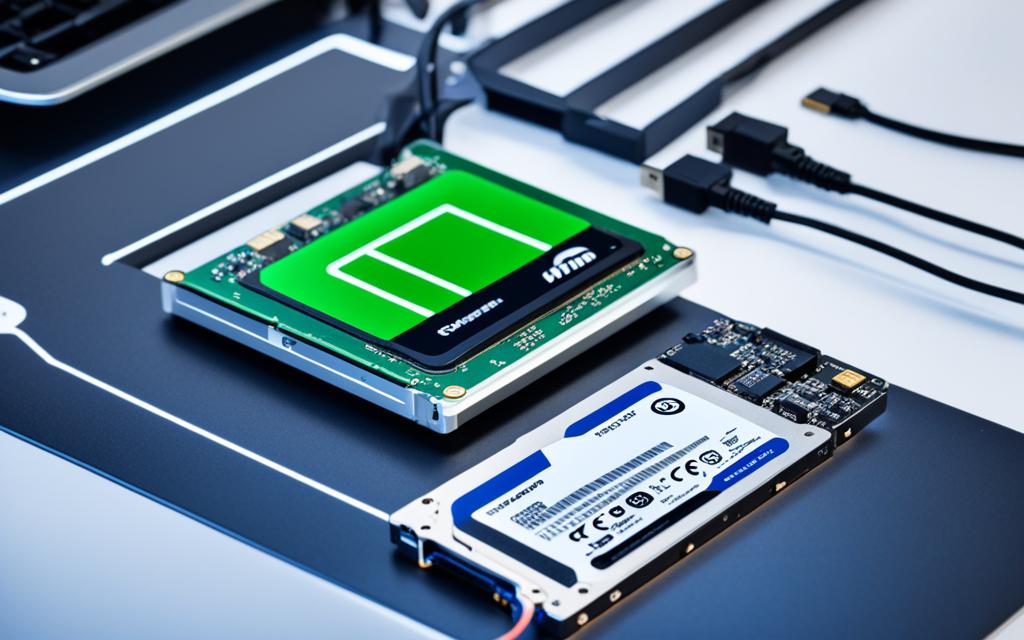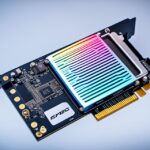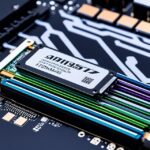Table of Contents
Transferring data from one SSD to another is ideal for anyone looking to boost their device’s storage or switch systems. SSDs offer a big leap in performance compared to Hard Disk Drives, especially in speed. This speed boost can make computers start and run much faster1. The fastest NVMe SSDs can reach read/write speeds over 3000 MB/s. Even faster, Gen 4 NVMe PCIe SSDs can hit speeds up to 7500 MB/s2.
SSDs also consume less power, which means devices can run longer on a single charge. They operate quietly since they lack moving parts1. Users enjoy a smoother and quieter experience. Plus, SSDs are tougher and can better withstand drops and bumps than HDDs1. This guide offers detailed methods for moving your data to a new SSD, focusing on cloning and backup and restore options for an easy transition.
Key Takeaways
- SSDs offer significantly faster read/write speeds than HDDs.
- Top-end SSDs, such as NVMe models, can reach extremely high transfer rates.
- Lower power consumption in SSDs contributes to longer battery life for devices.
- The quiet operation of SSDs enhances the overall user experience.
- SSDs provide better durability against physical shocks compared to HDDs.
- Migrating data can be efficiently done via disk cloning or backup methods.
Understanding SSDs and Their Benefits
As tech evolves, learning about data storage is key for top performance. Solid State Drives (SSD) are changing our view on storage, with big steps forward compared to Hard Disk Drives (HDD). We’ll explore what SSDs are, their main gains over HDDs, and why upgrading to SSD is a smart move.
What is an SSD?
An SSD stores data using non-volatile memory. It doesn’t have mechanical parts like HDDs. This means SSDs give you quick access to your data and boost the speed of reading/writing. Such speed boost is important for apps, operating systems, and gaming. It makes your computer work faster and more smoothly.
Key Advantages Over HDDs
SSDs have several key benefits:
- Speed: SSDs are up to 10 times quicker than HDDs, which you’ll see when your computer starts and when you move files3.
- Durability: SSDs aren’t hurt by shocks and temperature changes as much, thanks to having no moving parts3.
- Efficiency: They use less power and make less heat, which means laptops have better battery life and desktops save energy3.
Why Upgrade to a Larger or Better SSD?
People often run out of space with small SSDs and think about getting a bigger or better one. Getting more storage or a faster SSD can make your computer feel new. For instance, NVMe SSDs can move data more than 20 gigabytes per second. That’s way faster than SATA SSDs, which max out at 6 Gbps4. Upgrading gives you a big speed increase, especially for tasks that use lots of data.
Can I Transfer Data from One SSD to Another?
Moving data from one SSD to another is something many users need to do, especially when they want a bigger or better drive. There are a few SSD migration methods that help make sure your important data stays safe and ready to use.
Overview of Data Transfer Methods
It’s quite simple to move data between SSDs with a few tried and tested methods. Cloning the disk is a good way for a full drive transfer. For moving some of the data, the backup and restore strategy works well. If you’re just moving a few items, you might just copy and paste them, though this can take a while if there’s a lot to move5. Tools like MiniTool ShadowMaker use smart cloning to make the process fast and safe6.
Common User Scenarios for Transferring Data
There are many reasons someone might want to move their SSD data. Often, it’s because they need more space or want a faster SSD to boost their computer’s speed. When an SSD gets too full, moving data to a larger one is a better option than getting a new computer7. Software like AOMEI Backupper and EaseUS Disk Copy can make moving your important files and programs straightforward57.
Methods for Transferring Data Between SSDs
Various efficient methods exist for transferring data between SSDs. Each method offers distinct advantages and challenges. Knowing these methods can make data transfer smoother and reduce data loss risks.
Disk Cloning: A Quick Guide
Using disk cloning involves software like AOMEI Backupper or DiskGenius Free Edition. These tools directly clone the source SSD. This means not only does all content move over, but reinstalling applications is not needed. It’s a fast process, ideal for those needing quick access to data on the new SSD8. Make sure the target SSD is large enough beforehand, as it will overwrite existing data9.
Backup and Restore: Step-by-Step Process
The SSD backup and restore method starts with creating a backup onto an external drive. It’s perfect when you can’t connect both SSDs at once. Though a bit complex, it guards against data loss. After backing up, the data can be restored to the new SSD, duplicating the old drive’s content10.
Manual Transfer: Copying Files Directly
Manual SSD transfer suits smaller data moves. It involves linking both SSDs and picking files to copy via file explorer. This method is simple but can be slow for large data amounts. It’s best for moving selected files instead of large data bunches8.
| Method | Advantages | Disadvantages |
|---|---|---|
| Disk Cloning | Fast, includes OS and applications | Removes existing files on target SSD |
| Backup and Restore | Safeguard data loss, non-direct connection | More time-consuming, complex |
| Manual Transfer | Simple, selective copying | Time-consuming for large data sets |
For a detailed guide on data transfer, resources are available. They cover different methods and software for managing SSDs10.
Choosing the Right Tools for Data Transfer
When you’re moving data between SSDs, it’s key to have the right tools. We’ll look at software and hardware that make data management easy and safe.
Recommended Disk Cloning Software
EaseUS Disk Copy stands out as a great choice for cloning. It works with Windows systems from 11 down to 711. You can clone systems, disks, and partitions fast11. AOMEI Backupper Professional is also up there for its ease of use across different Windows versions12. It helps move your Windows OS to a new SSD quickly, using System Clone or Disk Clone12.
Backup Solutions for SSDs
Having strong backup solutions is important for keeping SSD data safe. EaseUS Todo Backup offers thorough disk and file backup choices11. AOMEI Backupper ensures you can back up your system and files securely12. This way, your data stays intact during transfers.
SSD Connection Options: Cables and Enclosures
The right connection equipment matters a lot for transferring data successfully. SATA to USB cables and SSD enclosures help you hook up extra SSDs easily. They’re great for systems with few internal slots. These tools are user-friendly and portable, making data transfers a breeze.
Conclusion
Nowadays, it’s easier to move data between SSDs, thanks to various methods that fit different needs. Whether you’re cloning disks, backing up and restoring, or copying manually, these methods help you handle your SSD data smoothly. Moving to a larger SSD is common and necessary for more space. These new drives speed up your computer, making everything work faster and better1314.
Tools like EaseUS Disk Copy offer a smooth way to switch to a new SSD while keeping your data safe. This makes it a great option for those wanting to upgrade without hassle. Windows also has simple tools that make moving an Operating System easy, without losing data or causing crashes13. Keeping your data safe during these changes is crucial. It’s important to use methods that protect your information and keep your system stable.
To sum up, whether you use professional software or go the manual route, understanding the effects of your choices is key. A good SSD move not only meets your current needs but improves your computing experience. You can learn more about transferring SSD data by following this link.
FAQ
What benefits do SSDs provide over HDDs?
SSDs are faster than HDDs in reading and writing data. They use less power, create less heat, and are more durable because they have no moving parts.
Can I transfer data while using different brands of SSDs?
Transferring data between SSDs of different brands is possible. The process is the same if you use the right tools, like disk cloning or backup and restore methods.
How long does it typically take to transfer data between SSDs?
Transfer time varies depending on the transfer method and the data size. Disk cloning is quick, taking from a few minutes to an hour. Manual transfers might take longer, based on the size of the files.
Is it necessary to format the new SSD before transferring data?
If you’re cloning the drive, you don’t need to format the new SSD. It copies everything over, including the file system. If you’re using backup and restore, or starting fresh, then formatting the new SSD is recommended.
What are the best practices for ensuring a safe data to transfer process?
Ensure a smooth transfer by backing up your data first. Make sure both SSDs are connected correctly. Use trusted cloning software and check the files’ integrity after transferring.
Can I use SSDs interchangeably with my existing hardware?
Most SSDs work with current hardware. However, check the connection types and make sure your system supports the SSD, especially for SATA and NVMe interfaces.
How do I know when it’s time to upgrade my SSD?
It’s time to upgrade if you’re running out of space, if your SSD is slow, or if it’s old and lacks features like NVMe support.
Source Links
- https://www.diskpart.com/articles/how-to-transfer-data-from-hdd-to-ssd-7201.html – How to Transfer Data from HDD to SSD Drive in Windows 11/10/8/7?
- https://www.cdw.com/content/cdw/en/articles/hardware/ssd-types-m2-sata-nvme-u2.html – M.2 vs NVMe vs. 2.5″ vs. U.2 SSDS
- https://www.backblaze.com/blog/ssd-upgrade-guide/ – How to Upgrade Your Computer: Migrating from HDD to SDD
- https://www.ibm.com/think/topics/ssd-vs-nvme – SSD vs NVMe
- https://www.ubackup.com/clone/how-to-move-files-from-one-ssd-to-another-6688.html – How to Transfer Data/Files from One SSD to Another [2 Ways]
- https://www.minitool.com/backup-tips/transfer-data-from-one-ssd-to-another.html – How to Transfer Data from One SSD to Another? Try 2 Ways!
- https://www.easeus.com/disk-copy/clone-resource/how-to-transfer-data-from-one-ssd-to-another.html – How to Transfer Data/Files from One SSD to Another Without Losing Data
- https://4ddig.tenorshare.com/hard-drive/how-to-transfer-data-from-one-hard-drive-to-another.html – [Tutorial] How to Transfer Data from One Hard Drive to Another
- https://mobiletrans.wondershare.com/how-to/transfer-os-to-ssd.html – How to Transfer OS to SSD in Windows: A Step-by-step Guide [2024]
- https://www.diskgenius.com/resource/clone-c-drive-to-ssd-windows-10.html – How to Clone C drive to SSD in Windows 10/11 for Free? (2 Methods)
- https://www.easeus.com/disk-copy/clone-resource/how-to-transfer-operating-system-from-one-ssd-to-another.html – How to Transfer Windows 10/11 from One SSD to Another
- https://www.ubackup.com/windows-10/transfer-windows-10-from-one-ssd-to-another-6688.html – How to Transfer Windows 10 from One SSD to Another (2 Ways)
- https://dev.to/furkangozukara/how-to-transfer-os-from-one-ssd-to-another-drive-323j – How to Transfer OS from One SSD to Another Drive
- https://www.cocosenor.com/articles/computer/how-to-transfer-all-data-from-one-ssd-to-another.html – How to Transfer All Data from One SSD to Another








